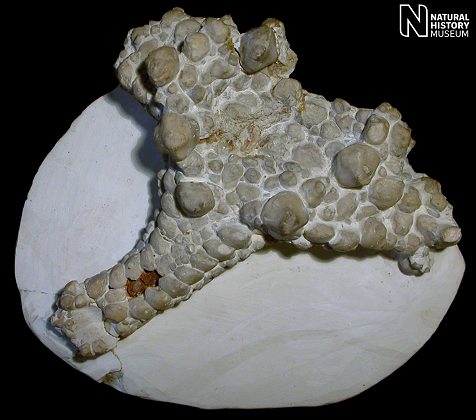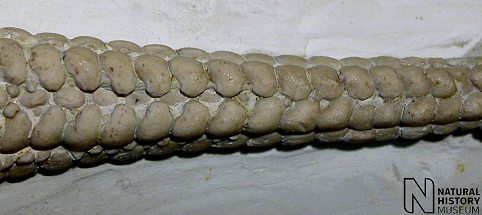
|
Stauranderaster coronatus (Forbes) |
Members of the genus Stauranderaster possess a swollen, well-armoured central disc and elongate arms. The various species can be recognised by the enlarged primary interadials (which define the crown of the central disc) and the centro-dorsal (which sits at the centre of the disc); for Stauranderaster coronatus these are conical, with a flared and notched base, and often a flattened apex. Though well preserved are very scarce, S. coronatus is the most common Grey Chalk Stauranderaster.

1). Aboral view of a large and unique specimen, exhibiting near perfect articulation of the slender arms (x1.2, Grey Chalk, Burham, Kent, Smith Collection, BMNH (British Museum (Natural History) London) E2562). Image © 2005 The Natural History Museum, by kind permission.

2). Aboral view of the partial type specimen; the enlarged primary interadials form a distinctive ring around the central disc (x1.4, Grey Chalk, Washington, Sussex, Dixon Collection, BMNH (British Museum (Natural History) London) 35480). Image © 2005 The Natural History Museum, by kind permission.
 A A |
 B B |
 C C |
3). Primary interadials; (A) Detail of the type specimen (Fig. 2) showing the distinctive primary interadials; (B) ventral (top) view of an isolated primary interradial of Stauranderatser cf. coronatus, and and (C) lateral (side) view showing the low-cone profile (x7.0, Grey Chalk, Lulworth Cove, Dorset, Randell Collection, RR1247. Image (A) © 2005 The Natural History Museum, by kind permission.
 A
A |
 B B |
4). Detail of the specimen in Fig. 1; (A) Ventral and (B) lateral views of an exceptionally well preserved arm (x2.8). Images © 2005 The Natural History Museum, by kind permission.